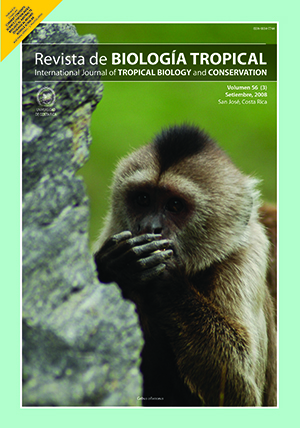Abstract
The growth of a forest patch through colonization of the adjacent matrix is mostly determined by the particular characteristics of the edge zone. Knowing how these characteristics are related to a specific edge type and how they influence the regeneration process, is important for High Andean forest edges restoration. This study aimed to characterize three types of High Andean forest edge in Cogua Forest Reserve (Colombia): 1) edge of Chusquea scandens, 2) “paramizado”, and 3) old edge, characterized for being in a later succes-sional state. Two forest patches were chosen for each edge type and 13 criteria were analyzed; these were of topographic order, micro-environmental order, vegetation structure and species composition. in each patch the vegetation was evaluated by means of two 60 m transects perpendicular to the edge and along the matrix-edge-interior of the forest gradient. All woody plant species were identified and counted to determine their abundance. Environmental variables (air temperature, relative humidity, wind speed, and light radiation) were measured in one of the transects. Three of the 13 criteria were of little importance in shaping the type of edge habitat (slope, patch shape and area). The others were closely related with the micro-environmental conditions and in turn with the vegetation structure and composition; this relationship confers particular characteristics to each edge type. The microclimate and floristic edge limits coincided; edges extend between 10 and 20 m into the forest depending on the edge type. The paramizado edge has the smallest environmental self-regulation capac-ity and is more exposed to fluctuations of the studied variables, because of its greatest exposition to the wind action and loss of the tallest trees (between 10 and 15 m) which regulate the understoreymicroclimate. This low environmental buffer capacity prevents the establishing of mature forest species (for example, Schefflera sp. and Oreopanax bogotensis) although they are found in other areas within the same patch. All these results show that the paramizado edge needs the most intervention for its restoration. The Chusquea scandens edge forest is the most sheltered since this species acts as a protecting shield. However it still needs to be controlled to allow the adjacent matrix colonization by the forest species and natural regeneration, as it does in the old edge type forest, which moreover has an intermediate self-regulating capacity relative to the other two. The vegetation composi-tion reveals that most of the edge species can also grow inside, beyond the forest edge.
##plugins.facebook.comentarios##

This work is licensed under a Creative Commons Attribution 4.0 International License.
Copyright (c) 2008 Revista de Biología Tropical






